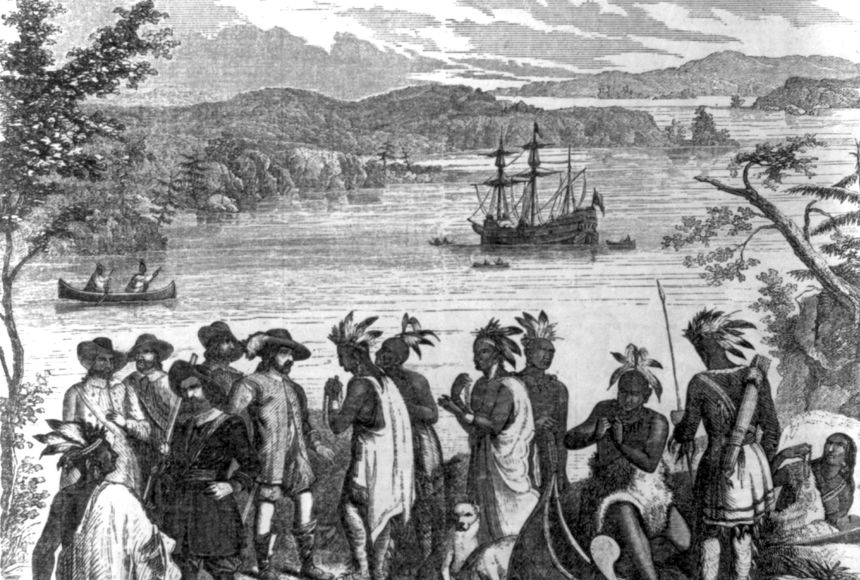One of America's earliest and most enduring legends is the story of Thanksgiving: that Pilgrims who had migrated to the new Plymouth Colony from England sat down with the local Wampanoag Indians to celebrate the first successful harvest in 1621. It makes for a great story—cultures coming together and sharing the bounty of the land that would eventually become America. However, the reality of interactions between colonists and the local Native American peoples is a far more complex story of trade, cooperation, and intense conflict as the two societies merged into America.
Finding Common Ground
In the 1600s, when the first English settlers began to arrive in New England, there were about 60,000 Native Americans living in what would later become the New England colonies (Plymouth, Massachusetts Bay, New Hampshire, Connecticut, New Haven, and Rhode Island). In the first English colonies in the Northeast (as well as in Virginia), there were initial conflicts and concerns over the threat colonists posed to the Native Americans’ long-established territory. Still, colonists were able to build thriving colonies with the help of locals.
Trade was one of the first bridges between New England colonists and local Native American populations. For the colonists, it was about building the infrastructure and relationships they would need to stay and thrive in the New World. For the Native Americans, it was often about building potential alliances. After only five years, the Plymouth Colony was no longer financially dependent on England due to the roots and local economy it had built alongside the native Massachusetts peoples.
Both sides benefited from the trade and bartering system established by the native peoples and the colonists. The Native Americans provided skins, hides, food, knowledge, and other crucial materials and supplies, while the settlers traded beads and other types of currency (also known as “wampum”) in exchange for these goods.
Ideas were traded alongside physical goods, with wampum sometimes carrying religious significance as well. The first Bible printed in the New World was actually a translation into the language of the Native American people of the Algonquin, suggesting that the dialogues between the colonists and Native Americans were not just political or practical in nature, but also spiritual.
The primary religion of the New England colonies was the strict Puritan Christianity originally brought to the Massachusetts Bay colony by ships like the Mayflower, but as the colonies grew and changed, some of the colonists began to move away from that base. So too did views on the Native Americans who shared their land. A famous example of this is Roger Williams, whose rebellion against the religious powers-that-be led him to create the colony of Rhode Island. Williams held the unorthodox view that the colonists had no right to occupy land without purchasing it from the Native American peoples living there.
Over time, however, relations between the now-established colonies and the local peoples deteriorated. Some of the problems were unintentionally introduced by the colonists, like smallpox and other diseases that the English settlers had unwittingly brought over on their ships. Although the colonists suffered diseases of their own early on, they were largely immune to the microbes they brought over to the New World. The local Native American populations, however, had no such immunity to diseases like smallpox, tuberculosis, measles, cholera, and the bubonic plague.
Some colonial leaders, such as the Puritan minister Increase Mather, believed that the illness and decimation of the New England Native Americans was an act of God to support the colonists’ right to the land: “[A]bout this time [1631] the Indians began to be quarrelsome touching the Bounds of the Land which they had sold to the English, but God ended the Controversy by sending the Smallpox amongst the Indians.” Some colonial governments used the devastation as a way to convert the natives to Christianity, making them into “praying Indians” and moving them to “praying towns,” or reservations.
The First Indian War
Colonist-Native American relations worsened over the course of the 17th century, resulting in a bloody conflict known as the First Indian War, or King Philip’s War. In 1675, the government of the Plymouth Colony in Massachusetts executed three members of the Wampanoag people. The Wampanoag leader, Philip (also known as Metacom) retaliated by leading the Wampanoags and a group of other peoples (including the Nipmuc, Pocumtuc, and Narragansett). Other peoples, including the Mohegans and Mohawks, fought the uprising with the English colonists.
The war lasted 14 months, ending in late 1676 after much of the Native American opposition had been destroyed by the colonial militias and their Native American allies. Ultimately, a treaty was signed in April 1678, ending the conflict.
With such heavy casualties on both sides, this war is considered one of the deadliest conflicts in American history. Both sides experienced devastating losses, with the Native American population losing thousands of people to war, illness, slavery, or fleeing to other regions. More than 600 colonists died in the course of the conflict, with dozens of settlements destroyed.
Centuries later, the New England colonies’ history shows the kind of duality that paints much of American history: The idea that native and immigrant cultures have come together to create the modern United States, coupled with the devastating conflicts and mistreatment that took place along the way.

